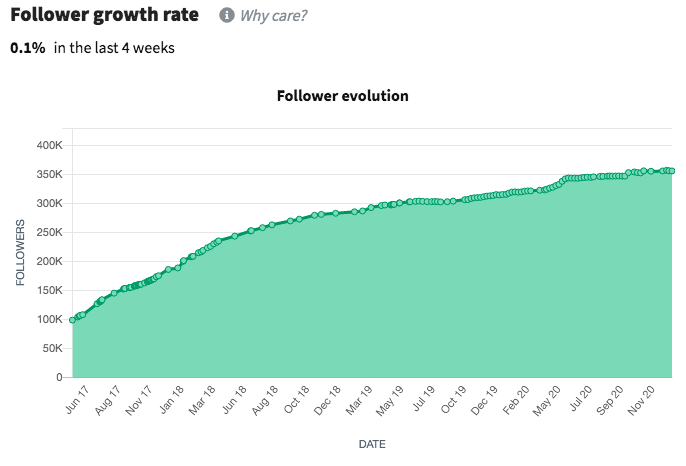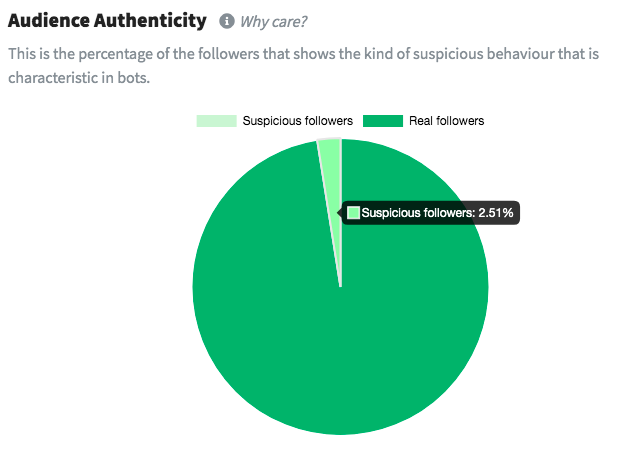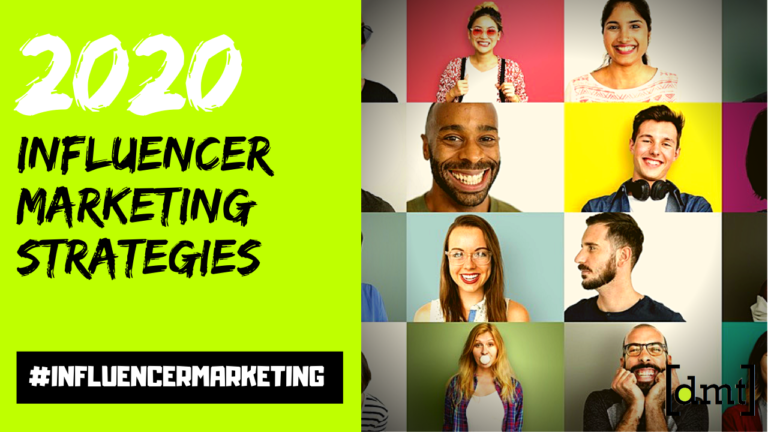When you need to find influencers for your social media marketing campaigns, it goes without saying you want to find influencers who can help you obtain a great ROI. In influencer marketing, that means someone who can connect their followers with your brand in a meaningful and authentic way.
But what if the influencer you end up choosing to collaborate with has loads of fake followers? Surely you don’t want to end up paying someone to show your products to bots, right?
How to Analyze Data to Detect Influencer Fraud? Share on X
Thankfully, there are some tried-and-tested ways to detect influencer fraud. You just have to know how to analyze an influencer’s performance-driven metrics. Keep reading to learn about the key metrics to analyze when evaluating an influencer’s authenticity.
Follower growth evolution
An influencer’s number of followers is obviously important. It determines an influencer’s reach, and also their price tag when it comes to collaboration fees. But you should know that when it comes to influencer marketing, the higher the follower count doesn’t always mean the better.
Micro influencers, for instance, have lower numbers of followers, but are very effective at brand collaborations. They’re great at connecting with their audiences, and they come across as authentic and genuine. And what’s better, they’re also cheaper to hire, so you save on your marketing budget.
But there’s something else you have to look at in connection with followers: how they are acquired. Examining follower growth over time can often reveal if an influencer has engaged in fraudulent practices.

The graphic above shows slow but steady follower growth. This means that the influencer is accumulating followers due to their content and personal brand. Organic growth isn’t an overnight process; it can take months or even years to achieve.
Fraudulent growth, on the other hand, generally appears like spikes and dips. If you see this type of growth, dig a bit deeper into the profile. Did the influencer recently host a giveaway? Did they have a viral moment? If neither of those is true, then they may have purchased fake followers. Analyze their audience authenticity— see more on that below— to verify if this is the case.
Followers/following ratio
While we’re talking about fraudulent followers, it’s important to touch on another social media strategy that skirts around organic growth. The follow/unfollow tactic is when an influencer follows random accounts and waits for them to return the favor. Later on, they unfollow those accounts. If you use social media, it’s probably happened to you!

@carlotaweberm has 356K followers and follows 1,104 people. This puts her followers/following ratio at 322:1 and suggests she’s not using the follow/unfollow tactic.
This tactic leaves the influencer with a puffed-up follower count. While these followers are real people, that doesn’t mean they’re actually interested in the influencer’s content. And that means they might not care in the slightest about promotional content for your brand.
Engagement rate
Engagement rate is a really important metric in influencer marketing, because it shows the connection between an influencer and their followers. The more interested and involved followers are with an influencer’s content, the more they’ll engage with it.
How can engagement rate reveal fraud? Well, first of all, you need to know the industry averages. Engagement rates vary by social network and number of followers. That is to say, Instagram and Youtube have different engagement averages. And so do Instagram influencers who have 10-50K followers and those who have 500K-1M followers.
So once you know the average for the network and follower range that apply to the influencer you’re assessing, you can see more accurately how they stack up. If you see extreme engagement on either end of the spectrum, fraud could be the reason why.

For example, as you can see in the chart above, engagement rate for Instagram influencers with more than 250K followers hovers around 2.5%. So engagement of 3.8% would be considered high. But if the engagement rate was 20%, it would be suspiciously high, and suggests that the influencer may have bought fake likes and comments.
Likewise, if you see engagement that is extremely low, it’s always a bad sign, but could be for one of two reasons. Maybe the influencer bought fake followers, who don’t contribute to engagement. Or, sadly, their content just isn’t interesting enough.
Audience demographics
Other data that can help reveal fraud relates to the influencer’s audience. Analyze their age, gender, location, language and interests to see if it seems logical that they would follow that influencer. An influencer doesn’t have to have everything in common with their audience. But they usually share some common demographics.
When looking at profiles who have millions of followers, expect to see followers of varying demographics – of all genders/ages, from countries around the world, and with diverse interests. Many people will follow famous influencers purely because they’re famous.

Nearly half of @carotaweber’s audience is located in Spain, where she is also based.
However, when evaluating influencers who aren’t the Selena Gomezes and Cristiano Ronaldos of social media, demographics can give us clues to fake followers. If you see, for example, that a fashion influencer from Buenos Aires who posts in Spanish has an audience who’s mainly located in Russia, speaks Russian, and is interested in gaming, something may be up.
Audience authenticity
Finally, vet the authenticity of an influencer’s audience. Do their followers look like real people? Or do they exhibit the behaviors that we tend to see in bots? Bots may not have a profile picture or biography. Their names are sometimes random strings of letters and numbers. And their comments sound unnatural and are sometimes completely off-topic or even inappropriate.

An audience authenticity analysis from an influencer marketing platform.
You can analyze authenticity directly on social media, but a quicker way is using an influencer marketing platform. This type of software requires a paid subscription, but it uses AI to do the analysis for you, which saves time and resources for your brand.
An influencer marketing platform also provides a search engine for influencer profiles, which means you don’t have to sift through profiles directly on the social network.
Conclusion
Social media isn’t safe from fraud, and there are a variety of techniques that influencers use to falsify their profiles. That’s why it’s so important to not just look at an influencer’s number of followers and the pictures they post. You also need to analyze how well their profile performs and what’s going on behind the scenes.
Recommended Read:
UPCOMING TRENDS IN DIGITAL MARKETING THAT YOU SHOULD NOT IGNORE THIS 2021
TOP 10 DIGITAL MARKETING SKILLS YOU NEED TO LEARN IN 2021
5 BEST ONLINE DIGITAL MARKETING COURSES IN 2021
General FAQs
Influencer marketing is built on authenticity, so identifying fake followers is the first line of defence against fraud in the industry.
The first option for calculating your Instagram engagement rate is to divide your total number of likes and comments by your follower count, and then multiply by 100 to give you a percentage.
Generally, you want to see an engagement rate of 2-3% on influencers’ posts. A ratio of 4-6% is excellent, while posts in the high tens and twenties are considered “viral.”




